
CUP (2019) p/b 200pp £16.99 (ISBN 9781108706094)
‘Sophoclean scholars, it seems’, wrote Colin Austin (quoted by F.), ‘live in a private world of their own, blissfully unaware of what their predecessors or contemporaries have been up to.’ Happily, the same cannot be said of F. in this present book. Instead, in a short, elegant monograph (just 105 pages of text plus introduction, bibliography and index of passages discussed) he not only explores an impressively wide range of subject areas but interweaves discussion of current and previous scholarship, including the work of often-sidelined scholiasts.
Aimed primarily at a readership not of ‘professional scholars working on Greek tragedy’ but ‘of postgraduates needing direction in a new field of study; of advanced undergraduates … who want some context for their studies; of teachers of Classics … who would like a convenient recent guide and stimulus; and of scholars in other fields and readers more generally, who … would like to think more about [Sophocles’] works’, and with every quotation in Greek accompanied by a good English translation, the book is divided into two unequal sections: first Transmission (three chapters), then Interpretation (seven).
While at first it might seem perverse to discuss the afterlife before the life itself, it does in fact make perfect sense: a knowledge of how texts came down to us and an awareness of how commonly-held assumptions evolved enable us to adopt a more forensic approach when interpreting the plays themselves. It is also a fascinating field in its own right: the evolution from script intended to be both performed in Athens’ Theatre of Dionysus and revived thereafter locally and internationally, to classic text championed by Alexander at Gedrosia, translated by Atilius in Rome, and studied by scholars in Alexandria, Byzantium and beyond, first printed in Italy and now researched and staged across the globe. It is only recently, however, that fragments (still being found and published) of otherwise lost plays have received proper scrutiny, but as F. brilliantly demonstrates in the second section of this book they can be vital to our (re)evaluation of Sophocles.
Thus Procne’s speech about women’s lives from Tereus informs our understanding of Deianira in Trachiniae, while a chilling scene from Niobe in which Apollo instructs Artemis to shoot dead a defenceless girl who is cowering in a storeroom (the setting described in devastatingly domestic language) causes us to question any assumptions we might entertain about Sophocles’ view of the gods. F. tackles other popular presuppositions, too, and other big, wide-ranging subjects—the nature of the Sophoclean hero, myth and rhetoric—but this does not stop him delving deep into such areas as language, metre and the importance accurate translation, boldly tearing out the tongue of meaning by its very roots (as he insists Ajax tears out the sheep’s tongue at Ajax, 238) not simply clipping at its tip.
While readers might regret the absence of real in-depth discussion of the political context in which individual plays were written (much changed in Athens, after all, between the late 440s when Antigone is said to have been staged and 405, the date F. gives for Oedipus at Colonus’ composition), the sheer wealth of other material more than compensates. Cleverly intertwining his explication of surviving plays within wider discussions, F. furnishes much food for further thought. To pick out further nuggets: the relationship between Sophoclean plays and those of his contemporaries; the ambiguous nature of many of their endings, perhaps a ‘cliff-hanger’ device inherited from earlier tragedians who (unlike Sophocles) wrote connected trilogies; the use of rhetoric to make specific situations appear universal; the reworking of mythology to achieve dramatic intensity—the list, which could go on much further, serves to illustrate how much material is packed into this short volume. F. might (indeed, does) conclude that ‘Sophoclean tragedy was, and remains, resistant to the tidy conclusion, to the neat drawing together of threads’, but it is nonetheless a treasure trove and one upon whose wealth F. has brilliantly shone a light.
One sentence, however, more than any other may perhaps remain seared in readers’ memories: discussing the transmission of the seven ‘canonical’ plays, F. observes, ‘the sudden collapse of the Byzantine state, or a reform of its teaching methods involving the removal of poetic texts from the syllabus, could easily have led to their total loss’. We must be thankful, then, both to Byzantium for Sophocles’ survival, and to F. for his contribution to our evolving appreciation of his work.
David Stuttard
